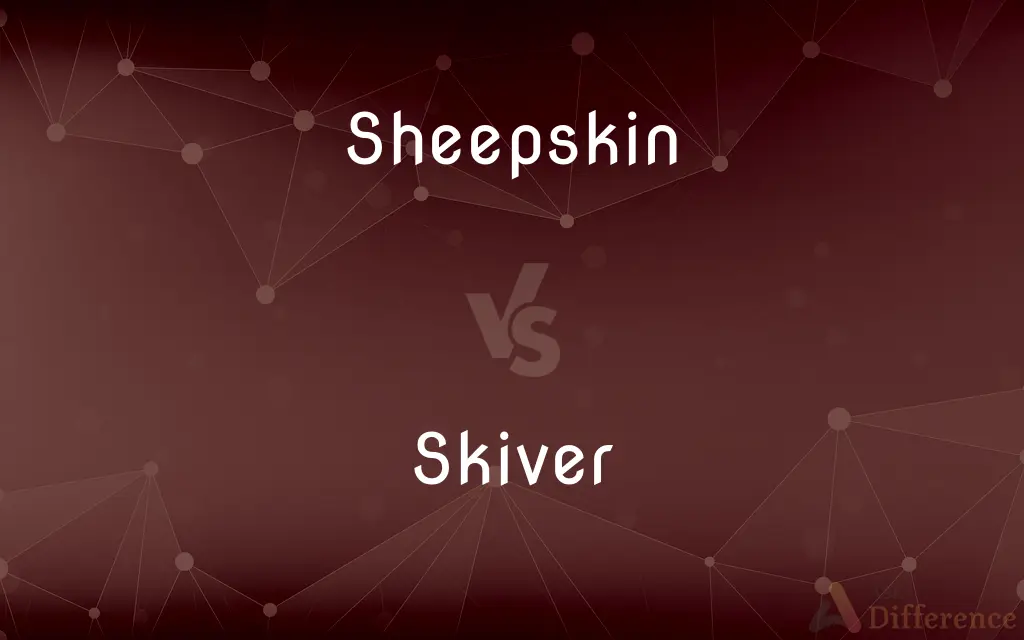Sheepskin vs. Skiver — What's the Difference?
By Urooj Arif & Fiza Rafique — Updated on May 21, 2024
Sheepskin refers to the hide of a sheep with its wool still attached, while skiver is a thin, soft leather made from the split of sheepskin or other animal hides, often used in bookbinding and small leather goods.

Difference Between Sheepskin and Skiver
Table of Contents
ADVERTISEMENT
Key Differences
Sheepskin is the hide of a sheep that typically includes the wool. It is known for its warmth, softness, and versatility, used in clothing, rugs, and upholstery. The natural insulating properties of sheepskin make it ideal for products designed to provide warmth and comfort. Skiver, on the other hand, is a thin, soft leather made from the outer split of sheepskin or other animal hides. It is primarily used in bookbinding, small leather goods, and decorative applications due to its pliability and smooth surface.
While sheepskin is valued for its dual characteristics of leather and wool, skiver is prized for its lightweight and delicate texture. Sheepskin’s woolly surface offers a rustic and natural look, whereas skiver provides a refined and elegant finish suitable for intricate work.
Sheepskin is often left in its natural state or minimally processed, preserving the wool's texture. In contrast, skiver undergoes significant processing to achieve its thinness and smooth texture, making it ideal for more detailed and artistic uses.
Both materials originate from sheepskin, but their applications and processing methods result in different products with unique characteristics and uses.
Comparison Chart
Definition
Hide of a sheep with wool attached
Thin, soft leather made from sheepskin or other hides
ADVERTISEMENT
Wool Presence
Yes
No
Main Uses
Clothing, rugs, upholstery
Bookbinding, small leather goods, decorative items
Texture
Woolly and soft
Smooth and fine
Processing
Minimal, preserving natural wool
Extensive, to achieve thinness and smooth texture
Appearance
Natural, rustic
Refined, elegant
Compare with Definitions
Sheepskin
A material known for its warmth and softness.
The sheepskin rug added a cozy touch to the room.
Skiver
Thin, soft leather made from the outer split of sheepskin.
The book was bound in fine skiver.
Sheepskin
The hide of a sheep, usually with the wool still attached.
She bought a sheepskin coat for the winter.
Skiver
A material used in bookbinding and small leather goods.
The skiver wallet was elegant and lightweight.
Sheepskin
A natural material often left in its raw form.
The sheepskin throw was a popular item at the craft fair.
Skiver
Often used in decorative applications.
The skiver was embossed with a beautiful pattern.
Sheepskin
Used in making various clothing and upholstery items.
The car seats were covered in luxurious sheepskin.
Skiver
Known for its pliability and smooth texture.
Skiver leather is perfect for intricate designs.
Sheepskin
Valued for its insulating properties.
Sheepskin slippers keep your feet warm in the coldest weather.
Skiver
One, such as a cutting tool, that pares or skives.
Sheepskin
Sheepskin is the hide of a sheep, sometimes also called lambskin. Unlike common leather, sheepskin is tanned with the fleece intact, as in a pelt.
Skiver
A soft thin leather split off the outside of sheepskin and used for bookbinding.
Sheepskin
The skin of a sheep either tanned with the fleece left on or in the form of leather or parchment.
Skiver
A person who avoids work or duty.
Sheepskin
(Informal) A diploma.
Skiver
A slacker.
Sheepskin
(uncountable) The skin of a sheep, especially when used to make parchment or in bookbinding.
Skiver
A truant; one who is absent without permission, especially from school.
Sheepskin
A diploma.
Skiver
One who uses a skive (or skives).
Sheepskin
The tanned skin of a sheep with the fleece left on, especially when used for clothing, rugs, etc.
Skiver
(dialect) A skewer.
Sheepskin
The skin of a sheep; or, leather prepared from it.
Skiver
An inferior quality of leather, made of split sheepskin, tanned by immersion in sumac, and dyed, formerly used for hat linings, pocketbooks, bookbinding, etc.
Sheepskin
A diploma; - so called because usually written or printed on parchment prepared from the skin of the sheep.
Skiver
The cutting tool or machine used in splitting leather or skins.
Sheepskin
Tanned skin of a sheep with the fleece left on; used for clothing
Skiver
To skewer, impale.
Sheepskin
Skin of a sheep or goat prepared for writing on
Skiver
An inferior quality of leather, made of split sheepskin, tanned by immersion in sumac, and dyed. It is used for hat linings, pocketbooks, bookbinding, etc.
Sheepskin
A document certifying the successful completion of a course of study
Skiver
The cutting tool or machine used in splitting leather or skins, as sheepskins.
Skiver
Typically processed to achieve a delicate finish.
She used skiver to cover the journal.
Common Curiosities
What are common uses for sheepskin?
Sheepskin is commonly used in clothing, rugs, and upholstery.
What is sheepskin?
Sheepskin is the hide of a sheep with the wool still attached.
How is sheepskin processed?
Sheepskin is minimally processed to preserve the natural wool.
Can skiver be used for upholstery?
Skiver is generally too thin for upholstery and is better suited for smaller, detailed work.
Is skiver made only from sheepskin?
No, skiver can be made from sheepskin or other animal hides.
What is skiver?
Skiver is a thin, soft leather made from the outer split of sheepskin or other hides.
Does sheepskin always have wool on it?
Yes, sheepskin usually includes the wool.
Can sheepskin be dyed?
Yes, sheepskin can be dyed various colors.
Does skiver contain wool?
No, skiver does not include wool.
Can skiver be dyed?
Yes, skiver can be dyed and embossed with patterns.
Is skiver durable?
Skiver is delicate and not as durable as thicker leathers.
Which is more expensive, sheepskin or skiver?
Sheepskin can be more expensive due to its larger size and wool content, whereas skiver, being thinner, is generally less costly.
What are common uses for skiver?
Skiver is commonly used in bookbinding, small leather goods, and decorative items.
How is skiver processed?
Skiver undergoes extensive processing to achieve its thinness and smooth texture.
Is sheepskin durable?
Yes, sheepskin is durable and provides good insulation.
Share Your Discovery

Previous Comparison
Excel vs. Access
Next Comparison
Beak vs. BillAuthor Spotlight
Written by
Urooj ArifUrooj is a skilled content writer at Ask Difference, known for her exceptional ability to simplify complex topics into engaging and informative content. With a passion for research and a flair for clear, concise writing, she consistently delivers articles that resonate with our diverse audience.
Co-written by
Fiza RafiqueFiza Rafique is a skilled content writer at AskDifference.com, where she meticulously refines and enhances written pieces. Drawing from her vast editorial expertise, Fiza ensures clarity, accuracy, and precision in every article. Passionate about language, she continually seeks to elevate the quality of content for readers worldwide.
















































